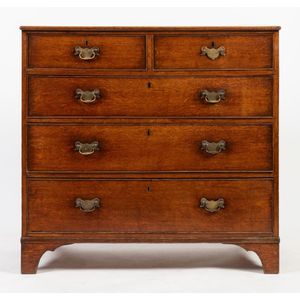18th Century Georgian Honey Oak Chest with Batwing Brass Handles
A Georgian honey oak chest, 18th century, the surface with vigorous medullary rays, two short above three long cockbeaded and pine lined drawers, with batwing brass plates and swan neck handles and raised on shaped bracket feet, 98 cm high, 103 cm wide, 50.5 cm deep
You must be a subscriber, and be logged in to view price and dealer details.
Subscribe Now to view actual auction price for this item
When you subscribe, you have the option of setting the currency in which to display prices to $Au, $US, $NZ or Stg.
This item has been sold, and the description, image and price are for reference purposes only.
- Medullary Rays - The medullary rays in timber are markings in the grain of ribbon form that extend through the tree and perpendicular to the growth rings. On oak they often display as a lighter coloured narrow ribbon, compared with the surrounding timber.
- Bracket Feet - On bracket feet the corner edge is square and joined by a mitre to its partner on the opposite angle. The inner edge is usually shaped or scalloped. Bracket feet were first introduced in the early 18th century and used until c. 1830 and are found on carcase furniture such as chests, cabinets, bookcases and bureaux.
Ogee bracket feet, a variation on straight bracket feet, have the outside edge forming an "S" shaped curve with the top bulging outward and the bottom turning inward.
On splayed bracket feet, the exterior edge curves outward. - Georgian - As an English stylistic period, Georgian is usually taken to cover the period from George I (1714) to the Regency of Prince George (1811-20), although the period from 1800 to 1830 is sometimes designated as the Regency period. During the Georgian period the great English cabinetmakers and designers such as Chippendale, Hepplewhite, Adam Sheraton etc., were all active.
Therefore there isn't a single 'Georgian style' as such and to say something is 'Georgian', usually means it was made between 1714 and 1830. This assumes we discount George V and George VI, both being from the 20th century.
The styles popular at the time of each reign were:
George I (1714-1727) saw out the last years of the Baroque period.
George II (1727-1760) reigned during the Rococo period.
George III (1760-1820) saw the last gasp of the Rococo, all of the early Neo-Classic 'Adam style' and most of the later neo-Classic 'Regency style'.
George IV (Prince Regent 1820-1830)encompassed the last of the 'Regency' style.
William IV's reign (1830-1837) was something of a no man's land (stylistically) and he wasn't a 'George' anyway. He covered the last glimmerings of 'Regency' and the start of the 'Victorian' style. - Swan Neck Pediment - Most commonly found on clocks, cabinets and bookcases, a swan neck pediment is formed by two flattened "S" shapes which almost meet in the centre. The form was derived from classical architecure and popularised by Chippendale in the 18th century. A true pediment is triangular in shape, and as a swan neck pediment does not meet at the apex of the triangle it is known as a "broken pediment". Swan neck pediments are also known as scrolled pediments.
This item has been included into following indexes:
- chests of drawers, material
- chests of drawers, period - Georgian 777
